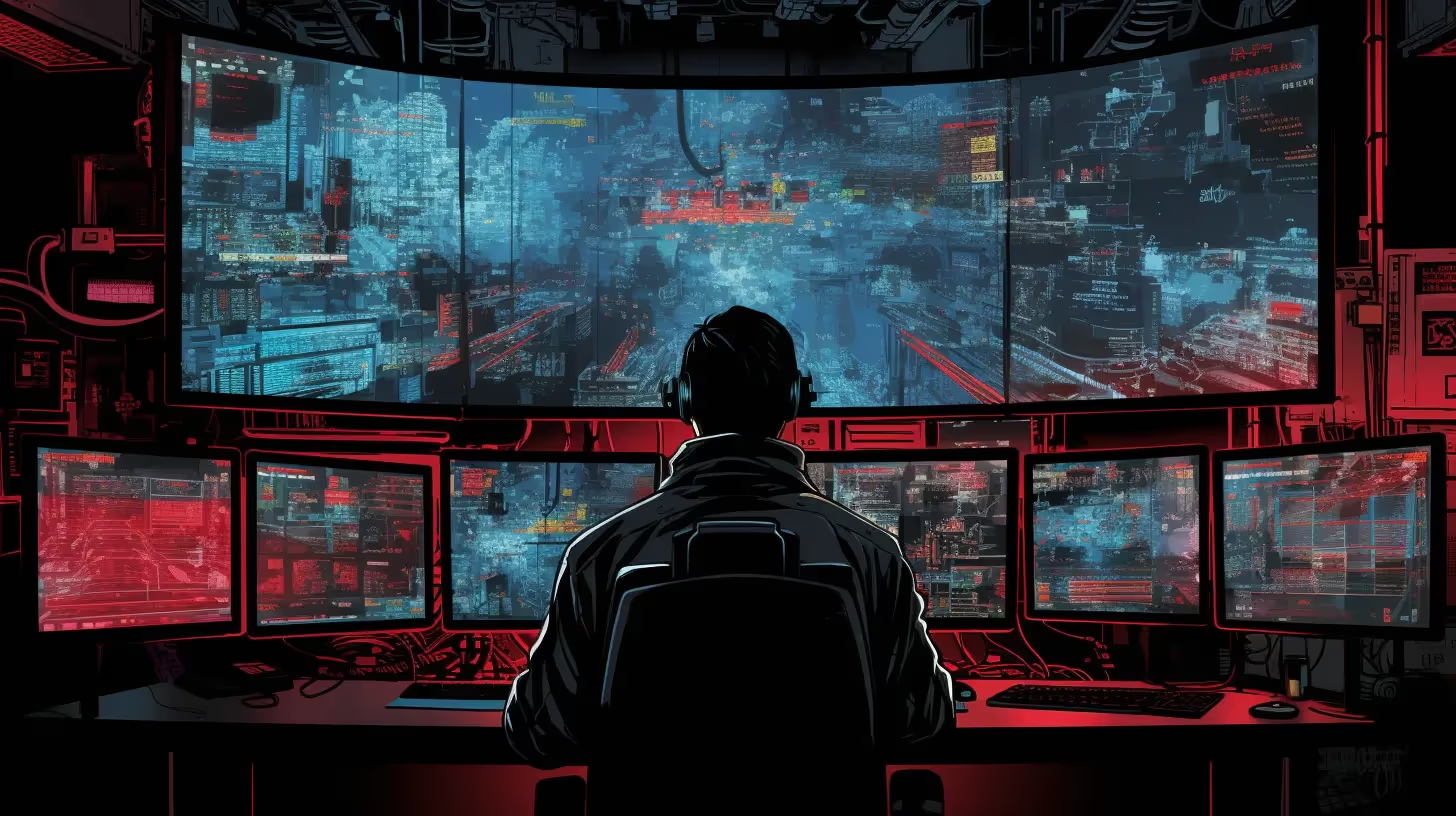Welcome to our comprehensive guide on computer imaging in IT asset management. This article will walk you through the seven essential steps of computer imaging, a pivotal process in maintaining control over your organization's IT infrastructure. Whether you are a CIO, IT director, or asset manager, understanding these steps will empower you to streamline your IT operations and ensure the efficiency and security of your systems.

What is Computer Imaging?
Computer imaging, often called "system imaging" or "disk imaging," is a fundamental process in IT asset management. It plays a crucial role in streamlining the deployment and management of computer systems within organizations. In this article, we'll delve into the concept of computer imaging, its significance, and how it can benefit top-tier executives such as CIOs, IT directors, and asset managers.
Understanding Computer Imaging
Computer imaging involves creating a complete and exact copy (image) of a computer's hard drive or storage media. This image includes the operating system and all installed software, configurations, and data. It captures the entire state of a computer system at a specific point in time.
The Role of Computer Imaging
Computer imaging serves several vital purposes:
Rapid Deployment:
Organizations can swiftly deploy new computers with preconfigured software and settings by creating standardized images. This reduces setup time and minimizes the risk of errors during installation.
System Restoration:
In the event of system failures or data corruption, computer imaging enables quick system restoration to a known, stable state. This minimizes downtime and ensures business continuity.
Uniformity:
Computer imaging ensures uniformity across an organization's computer systems. All devices can be configured identically, ensuring consistent user experiences and reducing support complexities.
Benefits for Top-Tier Executives
Now that we've established computer imaging let's explore why it matters to top-tier executives like CIOs, IT directors, and asset managers.
Streamlined IT Management
Computer imaging simplifies the management of IT assets on a large scale. Executives can oversee the deployment of software updates, security patches, and system configurations with ease, ensuring that all devices are up-to-date and secure.
Cost Savings
Efficient IT asset management, including computer imaging, helps organizations optimize their IT investments. By reducing manual setup time and minimizing errors, executives can cut operational costs and improve the overall cost-efficiency of their IT infrastructure.
Enhanced Security
Uniform system configurations through computer imaging facilitate better security practices. Executives can enforce consistent security policies across all devices, mitigating vulnerabilities and ensuring data protection.
Regulatory Compliance
For organizations subject to regulatory requirements, computer imaging can assist in maintaining compliance. Executives can ensure that all systems adhere to necessary standards and can demonstrate compliance when required.

Computer Imaging: Step One
In the previous section, we introduced the concept of computer imaging and its significance in IT asset management. Now, let's delve into the first step of the computer imaging process, which is crucial for organizations aiming to streamline their IT operations.
Step One: Define Imaging Requirements
Clearly defining your imaging requirements is essential before starting the computer imaging journey. This initial step lays the foundation for a successful imaging strategy. Here's what you need to consider:
Identify the Purpose
Determine why you need computer imaging. Are you deploying new computers across your organization, or is this for disaster recovery and system restoration? Clearly outlining the purpose will guide the rest of your imaging process.
Hardware Compatibility
Ensure your computer imaging solution is compatible with the hardware you intend to image. Different devices may require specific imaging approaches or drivers.
Software Configuration
Decide on the software configurations you want to include in your computer image. This includes the operating system, applications, and settings. List all the software components that should be part of the image.
Licensing and Compliance
Verify the licensing requirements for the software included in your image. Ensure compliance with software licenses and any legal obligations related to using specific applications.
Image Storage and Backup
Determine where you will store your computer images. Implement a robust backup strategy to safeguard your images against data loss. Redundancy is key to ensuring availability when you need it.
Documentation
Thoroughly document your imaging process. This documentation will serve as a reference for future imaging tasks and troubleshooting.

Computer Imaging: Step Two
Our previous discussions covered the importance of defining imaging requirements in step one of the computer imaging process. Now, let's move on to the second step, exploring the actions and considerations involved in creating a successful computer image.
Step Two: Prepare Source Systems
Creating a computer image requires careful preparation of the source systems. This step ensures that the systems you intend to image are in the optimal state for capturing a clean and reliable image. Here's what you need to do:
Backup Data
Before proceeding with any modifications, back up all critical data on the source system. This precautionary step prevents data loss during the imaging process.
Update Software
Ensure that the operating system and all software on the source system are up-to-date. Installing the latest updates, patches, and drivers helps eliminate vulnerabilities and ensures compatibility with your imaging solution.
Remove Unnecessary Software
Uninstall any unnecessary software applications or files from the source system. This step helps reduce the size of the image and ensures that only essential components are included.
Clean and Optimize
To optimize the source system's performance, perform system maintenance tasks, such as disk cleanup and defragmentation. A well-maintained system results in a more efficient and reliable image.
Disable Security Features
Temporarily disable or adjust security features like firewalls and antivirus software to prevent interference with the imaging process. Ensure you re-enable these features once the imaging is complete.
Create System Restore Point
Before proceeding, create a system restore point on the source system. This allows you to revert to the previous state if any issues arise during imaging.

Computer Imaging: Step Three
Continuing our exploration of the computer imaging process, we now arrive at step three, where we will focus on the actions and considerations involved in capturing the computer image.
Step Three: Capture the Computer Image
Capturing the computer image is a pivotal step in the imaging process. It involves creating a snapshot of the source system, including the operating system, software configurations, and data. Here's how to proceed:
Select Imaging Software
Choose a reliable imaging software tool that aligns with your organization's requirements. Ensure it supports the creation of bootable media for imaging, allowing you to deploy the image to multiple systems.
Create Bootable Media
Prepare bootable media with the selected imaging software, such as a USB drive or network boot image. This media will be used to boot the target systems for image deployment.
Configure Imaging Settings
Launch the imaging software on the source system and configure the imaging settings. Define the destination for the image file and specify any compression or encryption options as needed.
Start the Imaging Process
Initiate the imaging process. The software will capture an exact copy of the source system, including the operating system, software installations, and data files. Depending on the size of the image and the system's performance, this process may take some time.
Verify Image Integrity
After image capture is complete, perform a verification check to ensure the integrity of the image. Compare it to the source system to confirm that all components have been successfully captured.
Store the Image Securely
Store the computer image securely in a designated location. Ensure it is accessible when needed for deployment or system restoration. Implement backup procedures to safeguard against image loss.

Computer Imaging: Step Four
In step four of our computer imaging process, we will explore the actions and considerations related to deploying the captured computer image to target systems.
Step Four: Deploy the Computer Image
Deploying the computer image is a crucial step in the computer imaging process. It involves transferring the captured image to target systems, ensuring they are configured identically to the source system. Here are the key steps to follow:
Prepare Target Systems
Before deployment, ensure that the target systems are ready. This includes verifying that the hardware is compatible with the image, backing up any data on the target systems, and ensuring they are clean.
Boot from Bootable Media
Boot the target systems from the bootable media you created earlier, which contains the imaging software. This allows you to initiate the deployment process.
Select the Image
Using the imaging software on the bootable media, select the computer image you wish to deploy. Ensure that the software recognizes the image file and is ready for deployment.
Configure Deployment Settings
Configure the deployment settings as needed. This includes specifying the target location for the image, choosing whether to overwrite existing data and selecting any customization options.
Start Deployment
Initiate the deployment process. The imaging software will transfer the image to the target systems, overwriting their existing configurations and data with the contents of the image.
Verify Deployment
After deployment, perform a verification check to ensure the target systems are identical to the source system. Test the deployed systems to ensure all software and settings are correctly configured.
Restore Data
If necessary, restore any data backed up from the target systems before deployment. This ensures that users have access to their data after the imaging process.

Computer Imaging: Step Five
In step five of our computer imaging process, we will explore the actions and considerations related to maintaining and managing computer images after deployment.
Step Five: Manage and Maintain Computer Images
Once computer images have been deployed to target systems, managing and maintaining these images for ongoing operations and future needs is essential. Here's what you need to do:
Image Updates
Regularly update and maintain the computer images to reflect the latest software versions, security patches, and configurations. This prevents outdated or vulnerable images from being deployed.
Version Control
Implement version control for your computer images. Keep track of different image versions and changes made to each one. This helps maintain a history of image configurations.
Backup Images
Create backup copies of your computer images and store them securely. Having backup images ensures you can quickly recover from unexpected issues or changes.
Image Customization
Maintain flexibility in your imaging process by allowing for image customization when necessary. Not all systems require the same configurations, so that customizable image templates can be valuable.
Documentation
Keep detailed documentation of your computer images and their configurations. This documentation should include information about the software included, licensing details, and any unique settings.
Testing
Periodically test the deployment of computer images on a subset of systems to ensure they work correctly. Testing helps identify and address issues before deploying images on a larger scale.
Security
Maintain the security of your computer images by protecting them from unauthorized access. Implement access controls and encryption if necessary to safeguard sensitive configurations.

Computer Imaging: Step Six
In step six of our computer imaging process, we will explore the actions and considerations related to monitoring and optimizing computer imaging practices.
Step Six: Monitor and Optimize Computer Imaging
Monitoring and optimization are essential aspects of maintaining efficient computer imaging processes. Here's how to effectively manage this step:
Performance Monitoring
Regularly monitor the performance of your computer imaging infrastructure. Monitor factors such as imaging speed, resource utilization, and any bottlenecks in the process.
Error Tracking
Implement error tracking and reporting mechanisms. Identify and address any recurring errors or issues during image deployment.
Efficiency Analysis
Analyze the efficiency of your computer imaging workflow. Look for opportunities to streamline the process, reduce deployment times, and minimize resource consumption.
Image Size Optimization
Optimize the size of your computer images. Reducing image size can lead to faster deployment and lower storage requirements.
Scalability Planning
Consider the scalability of your imaging solution. Ensure it can handle an increasing number of systems as your organization grows.
User Feedback
Gather feedback from end-users and IT teams involved in image deployment. Their insights can help identify areas for improvement and enhance user satisfaction.
Documentation Updates
Keep your documentation updated with changes or optimizations made to the computer imaging process. This ensures that all team members are working with accurate information.

Computer Imaging: Step Seven
In the final step of our computer imaging process, we will explore the actions and considerations related to the post-deployment tasks and ensure the success of the imaging process.
Step Seven: Post-Deployment Tasks
After deploying computer images to target systems, it's essential to carry out post-deployment tasks to ensure that the process is successful and that systems function correctly. Here's what you need to do:
User Testing
Conduct user testing on the deployed systems to ensure end-users can work efficiently and without disruptions. Address any user-reported issues promptly.
Data Validation
Verify that all data has been correctly restored to the target systems if data backup and restoration were part of the imaging process. Ensure data integrity and accessibility.
System Monitoring
Implement continuous system monitoring to identify and address any performance issues or unexpected behavior on the deployed systems.
Documentation Review
Review and update your documentation to reflect any changes made during deployment. This ensures that your records accurately represent the current state of the systems.
Feedback Collection
Seek feedback from end-users and IT teams to gather insights into the success of the deployment. Identify any areas that require further attention or improvement.
Compliance Verification
Ensure that the deployed systems adhere to compliance standards and security policies. Conduct audits if necessary to confirm compliance.
Documentation Archive
Archive a copy of the documentation related to the deployment for future reference and auditing purposes.
Conclusion
In the fast-paced world of IT asset management, mastering the art of computer imaging is essential for maintaining control, efficiency, and security. This comprehensive guide has taken you through the seven crucial steps of computer imaging, from defining imaging requirements to post-deployment tasks. Implementing these steps effectively allows you to streamline IT operations, reduce downtime, and ensure your systems are always in top shape.
Please visit our services page to explore how UCS Logistics can assist you with IT asset management solutions, including computer imaging. Check out our About page for more information about our company and mission. If you have specific inquiries or require assistance, please get in touch with us.
Takeaways from the "7-Step Guide to Computer Imaging" article:
Importance in IT Asset Management: Computer imaging is crucial for efficient IT asset management, as it aids in deploying and managing computer systems in organizations.
Key Purposes of Computer Imaging: It serves for rapid deployment of systems, system restoration, and ensuring uniformity across an organization's computer systems.
Benefits for Executives: Simplifies IT management, leads to cost savings, enhances security, and helps in maintaining regulatory compliance.
Defining Imaging Requirements: Before starting, it’s vital to define imaging requirements, including purpose, hardware compatibility, software configurations, licensing, compliance, storage, and documentation.
Preparing Source Systems: Involves backing up data, updating software, removing unnecessary software, and optimizing the source system for creating a reliable computer image.
Reminder of the Article's Main Point: The article emphasizes the critical role of computer imaging in IT asset management, outlining a 7-step process to help CIOs, IT directors, and asset managers streamline their IT operations for efficiency and security.
Related searches for the article:
- Computer Imaging in IT Management
Search on Google - Benefits of System Imaging for Organizations
Search on Google - Steps in Computer Imaging Process
Search on Google - IT Asset Management Best Practices
Search on Google - Ensuring Compliance in Computer Imaging
Search on Google




